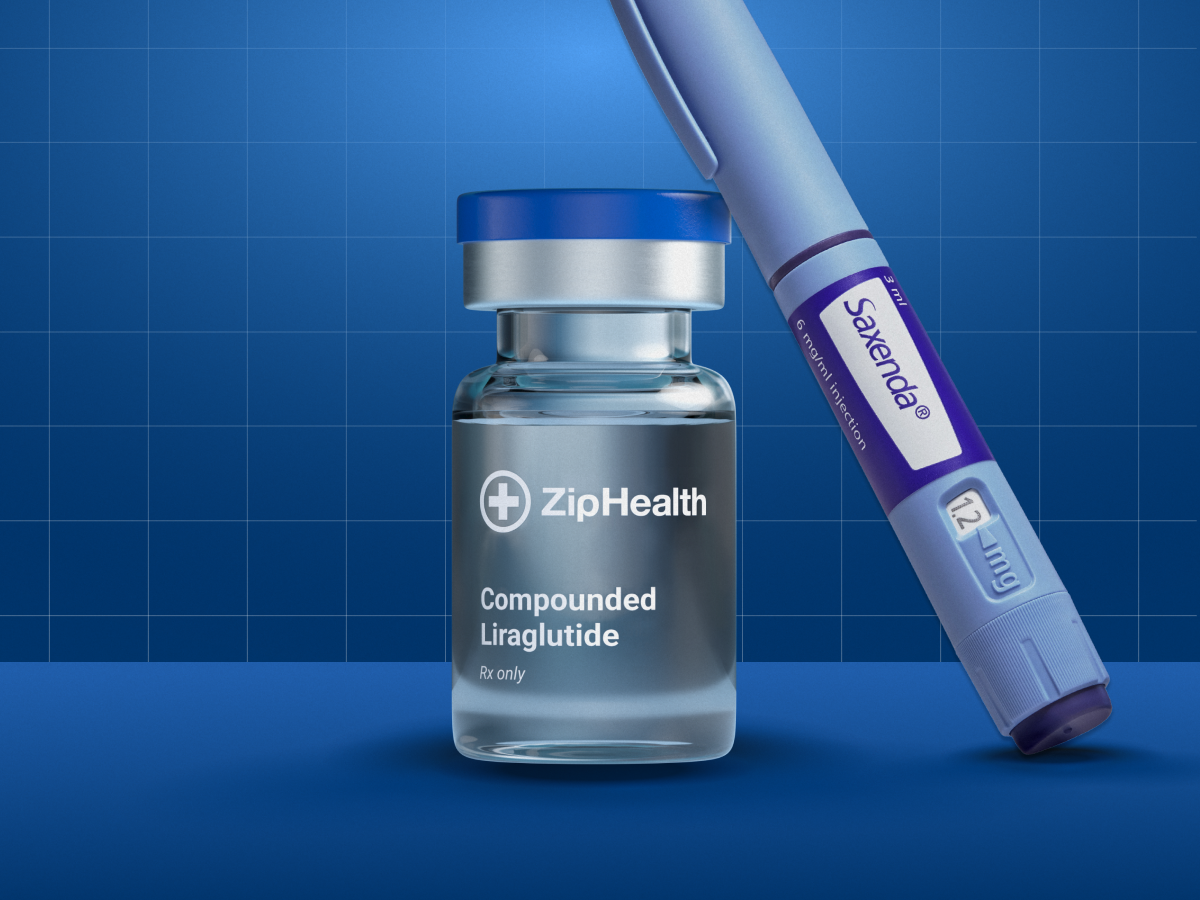Understanding Liraglutide: A Comprehensive Guide to Its Uses and Benefits
Discover how liraglutide, a GLP-1 weight loss injection, works to reduce appetite, manage blood sugar, and support safe weight loss.

With the growth of new injectable weight loss treatments, it can be difficult to know how each one works, and which is the best choice for you. Liraglutide, often sold under the brand name Saxenda, is just one of many innovative medications helping thousands of people lose weight across the globe.
Let’s dive into how it works, why it was first introduced, and how it could help you reach your weight loss goals.
What is liraglutide?
Liraglutide is a daily injectable medication primarily used to treat type 2 diabetes and obesity. It belongs to a group of medications named 'glucagon-like peptide-1 (GLP-1) receptor agonists', which are often referred to as 'GLP-1s', as a shorthand for the hormone they mimic. It's often sold under the brand name Saxenda®, but is also available *compounded at lower cost.
Other medications in this group include Ozempic, Wegovy and Mounjaro.
How does liraglutide and other GLP-1s support weight loss?
Liraglutide works in the same way as other popular GLP-1s by influencing two main factors:
Appetite
Liraglutide regulates your appetite by increasing feelings of fullness and reducing hunger levels. It also slows gastric emptying, which means that it takes longer for food to leave your stomach, helping you to eat less and stick to healthy lifestyle changes. [1]
Blood sugar
Liraglutide reduces your blood sugar levels by stimulating insulin (the hormone that lowers blood sugar) and lowering glucagon (the hormone that increases blood sugar) after you eat. This can help you fight cravings for high-calorie or sugary foods. [1]
When was liraglutide first introduced?
Liraglutide was first approved in Europe in 2009 and in the United States in 2010 for type 2 diabetes under the brand name Victoza®. It was later approved for weight loss management in the U.S. as Saxenda® in 2014 and in Europe in 2015.
Studies show an average weight loss of 8% by week 56 for patients taking liraglutide alongside a reduced calorie diet and increased physical activity. [2]
Medical history considerations
Liraglutide can't be prescribed to people with a family history of medullary thyroid carcinoma (MTC) or with multiple endocrine neoplasia syndrome type 2 (MEN 2).
Liraglutide side effects
As with all medications, it's possible to experience side effects when using GLP-1s like Saxenda® or Compounded* Liraglutide with B12. These can be different depending on various factors, including the dose you’re taking and how long you've had to adjust to the medication. Let's explore the most common.
Gastrointestinal Side Effects
Liraglutide affects your digestive system, so some of the most common side effects are gastrointestinal (digestive) symptoms. These include nausea, diarrhea, constipation and vomiting. [1] Most people find that digestive side effects improve within a few days to a week.
Nausea and Vomiting
Because Liraglutide helps food stay in your system longer, it can stretch your stomach. This sends signals to your brain that may lead to nausea. To manage nausea, our experts recommend drinking plenty of fluids (cold water, herbal teas), getting lots of fresh air, eating small and frequent meals, and avoiding foods high in sugar.
If your nausea leads to vomiting, you can also help by limiting yourself to bland foods, such as those in the BRAT diet: bananas, rice, applesauce and toast.
Diarrhea
When your digestive system is adjusting to liraglutide, you could experience diarrhea. You can help reduce this side effect by staying hydrated and eating small frequent meals. Oral rehydration salts can also replace lost fluids and electrolytes.
Constipation
As liraglutide slows down the movement of food through your digestive system, it may cause constipation. To manage constipation, drink plenty of fluids, eat high-fibre foods and take regular walks — exercise can encourage bowel movements.
Headache
If you experience vomiting or diarrhea from liraglutide, you could become dehydrated, which often leads to headaches. To manage symptoms, we recommend drinking plenty of fluids, using simple pain relief and making sure you’re getting enough sleep — experts recommend 7-9 hours per night.
Less common side effects
Less common side effects of liraglutide include: indigestion, fatigue, dizziness, stomach pain, heartburn, bloating, gas, dry mouth, gallstones, or reactions at injection site (for example, if your treatment is injected in your upper arm, you could notice a reaction there).
Uncommon side effects include dehydration and an increased heart rate.
Rare and serious side effects
Pancreatitis
Severe, persistent stomach pain could indicate pancreatitis, a serious condition that requires urgent medical attention. Here’s how to understand if you’re experiencing ‘severe’ pain:
- It’s so intense (around 8 or more out of 10) that you can’t focus on anything else.
- It makes it nearly impossible to handle normal daily tasks (like walking, getting dressed, or eating).
- It doesn’t improve with over-the-counter pain relief or rest.
- It radiates to your back or underneath your right ribcage or your right shoulder.
- You also have severe vomiting (3 or more times a day, or having blood or something that looks like coffee grounds in vomit).
Anaphylaxis
The following symptoms could indicate anaphylaxis or a severe allergic reaction that requires urgent medical attention. If you experience any of the following, stop taking your medication immediately.
- Difficulty breathing, or swelling of the lips, tongue, or throat.
- Severe pain underneath your right ribcage that may spread to your shoulder or back. This could be accompanied by vomiting, a high temperature or a rapid heartbeat.
Other rare but side effects include acute gallbladder disease and acute kidney injury. In serious medical situations, always call 911.
Ready to start your weight loss journey? Our clinical experts can help guide you through each step, and give advice on lifestyle changes, including diet and exercise support, and tips for side effects.
Start an online consultation today to find out if GLP-1s are right for you.
*Compounded drugs are permitted to be prescribed under federal law but are not FDA-approved and do not undergo FDA approval for safety, effectiveness, or quality.
At ZipHealth, our partner pharmacies are accredited by NAPB and LegitScript, guaranteeing strict adherence to FDA and state regulations. These pharmacies undergo frequent inspections to uphold the utmost standards of quality and safety. Our medications are subjected to rigorous testing, encompassing potency, pH levels, sterility, and endotoxicity checks, ensuring efficacy and safety.
References
[1] HIGHLIGHTS OF PRESCRIBING INFORMATION These highlights do not include all the information needed to use SAXENDA® safely and effectively. See full prescribing information for SAXENDA. SAXENDA (liraglutide) injection, for subcutaneous use Initial U.S. Approval: 2010 FORMS AND STRENGTHS [Internet]. Available from: https://www.accessdata.fda.gov/drugsatfda_docs/label/2018/206321s007lbl.pdf
[2] Pi-Sunyer X, Astrup A, Fujioka K, Greenway F, Halpern A, Krempf M, et al. A Randomized, Controlled Trial of 3.0 mg of Liraglutide in Weight Management. New England Journal of Medicine [Internet]. 2015 Jul 2;373(1):11–22. Available from: https://www.nejm.org/doi/full/10.1056/NEJMoa1411892
